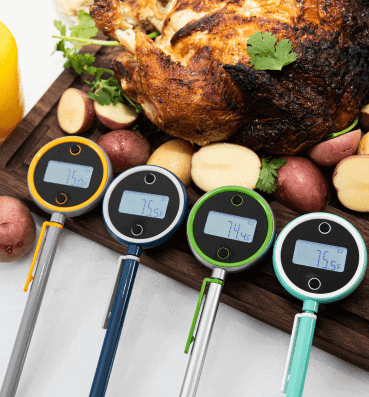Food Internal Temperature Chart
…
When working with foods like poultry, meat, fish, and eggs, cooking them to the right temperature is essential in preventing illness. Harmful bacteria like Salmonella and E. Coli thrive in many foods and can cause food-borne illness.
By learning the specific temperatures to follow and using a food thermometer when cooking at home, you can safely enjoy all your favorite meals without having to worry about getting sick.
According to the U.S. Department of Agriculture (USDA), verifying the internal temperature is the only way to gauge whether your food is sufficiently cooked. Research conducted by the USDA has shown that you cannot base your opinion on the appearance of the food alone; temperature must always be checked for confirmation.
Food Safety For All
At ChefsTemp, we seek to make food safety easier and more accessible for home cooks and pro chefs alike. Our high quality and user-friendly food thermometers like the Finaltouch X10 Digital Instant Read Thermometer offer anyone (regardless of cooking experience!) to practice food safety.
To make food safety even more accessible, our ChefsTemp team is sharing all of the Internal Cooking Temperature Cooking Charts that you need to know about. Whether you’re unsure of the right temperature for steak or looking for the perfect temperature for roasted veggies, we have got you covered. Print out these charts and bookmark this page so you can reference it whenever you need to!
- Steak, Lamb, Beef or Veal Temperature Chart
- Chicken, Turkey, Poultry Temperature Chart
- Pork Temperature Chart
- Fish and Seafood Temperature Chart
- Baked Goods Temperature Chart
- Candy or Sugar Syrup Temperature Chart
- Vegetables Internal Temperature Chart
- Water Temperature Chart
- Other Temperatures Reference
Carryover Cooking
When you are cooking meat, getting it to the table cooked just the way you like it is critical. To do that, you must hit the meat’s target temperature exactly. Having your meat 5 or 10 degrees off can make a huge difference to taste and texture. However, judging when meat is done is tricky, because what you are actually gauging is not whether the food is ready to eat right now – but whether it will be ready to eat once it has rested. Meat continued to cook even after it has been removed from the heat source, this is known as “carryover cooking”.
This happens for two reasons:
First, the exterior of a meat gets hot much more quickly than the interior. Second, because heat always moves from a hotter to a cooler area, as long as there is a difference in temperature between the two regions, heat will keep moving from the surface to the center even after you remove the meat from the heat source. This transfer will slow, and eventually stop, as internal and external temperatures approach each other and even out.
However, the process can result in a significant increase in temperature at the center of a large piece of meat, bringing it from a perfect pink to a disappointing gray. Investing in a meat thermometer will not only help you know the temperature of the meat while its cooking, but also help you gauge the perfect time get it to the table.










